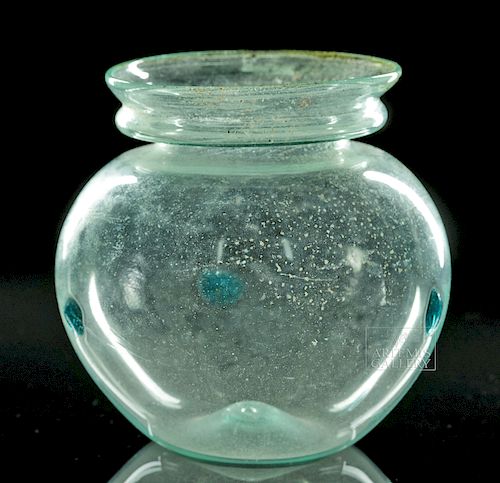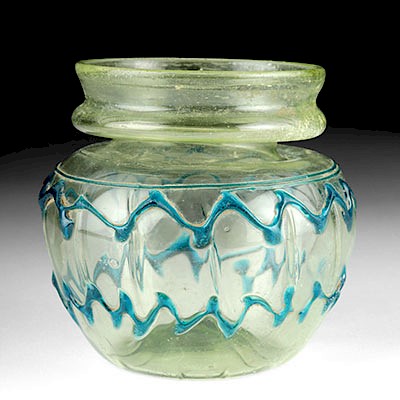Published Roman Glass Jar w/ Added Blue-Green Spots
Lot 33a
About Seller
Artemis Gallery
686 S Taylor Ave, Ste 106
Louisville, CO 80027
United States
Selling antiquities, ancient and ethnographic art online since 1993, Artemis Gallery specializes in Classical Antiquities (Egyptian, Greek, Roman, Near Eastern), Asian, Pre-Columbian, African / Tribal / Oceanographic art. Our extensive inventory includes pottery, stone, metal, wood, glass and textil...Read more
Estimate:
$2,500 - $3,500
Absentee vs Live bid
Two ways to bid:
- Leave a max absentee bid and the platform will bid on your behalf up to your maximum bid during the live auction.
- Bid live during the auction and your bids will be submitted real-time to the auctioneer.
Bid Increments
| Price | Bid Increment |
|---|---|
| $0 | $25 |
| $300 | $50 |
| $1,000 | $100 |
| $2,000 | $250 |
| $5,000 | $500 |
| $10,000 | $1,000 |
| $20,000 | $2,500 |
| $50,000 | $5,000 |
| $100,000 | $10,000 |
| $200,000 | $20,000 |
About Auction
By Artemis Gallery
Aug 16, 2018
Set Reminder
2018-08-16 10:00:00
2018-08-16 10:00:00
America/New_York
Bidsquare
Bidsquare : Clearance Sale - Ancient / Ethnographic Art
https://www.bidsquare.com/auctions/artemis-gallery/clearance-sale---ancient-ethnographic-art-3368
These lots are going, going, gone... plus a nice selection of lots brand-new to auction! Artemis Gallery info@artemisgallery.com
These lots are going, going, gone... plus a nice selection of lots brand-new to auction! Artemis Gallery info@artemisgallery.com
- Lot Description
**First Time At Auction**
Roman, late Imperial Period, ca. 4th century CE. A fabulous free-blown transparent glass vessel of a pale-green, near-colorless appearance with a concave base and a smooth pontil scar, a spherical body with a pronounced kick at the bottom, a collared rim, and a deep interior cavity. A trio of applied blue-green glass dots are presented equidistantly across the midsection of the body, imbuing the vessel with a burst of vibrant color. The elegant fire-polished surface and near-absence of any weathering gives this jar almost the exact same appearance as it had in antiquity. A stunning example of high-quality Roman glassware! Size: 4.425" W x 4.5" H (11.2 cm x 11.4 cm).
Pliny the Elder paid homage to the beauty of the many hues created in hand-blown glass, but pointed out that colorless translucent glass was the most coveted, "There is, furthermore, opaque white glass and others that reproduce the appearance of fluor-spar, blue sapphires or lapis lazuli, and, indeed, glass exists in any color . . . However, the most highly valued glass is colorless and transparent, as closely as possible resembling rock-crystal." (Pliny, Natural History XXXVI.198 from "Solid Liquid" catalogue, Fortuna Fine Arts, New York, 1999, p. 64.)
Published in "Solid Liquid: Greek, Roman, Byzantine and Islamic Glass." Fortuna Fine Arts, Ltd., New York, 1999, p. 112, fig. 202.
Provenance: private East Coast, USA collection
All items legal to buy/sell under U.S. Statute covering cultural patrimony Code 2600, CHAPTER 14, and are guaranteed to be as described or your money back.
A Certificate of Authenticity will accompany all winning bids.
We ship worldwide and handle all shipping in-house for your convenience.
#137054Some yellowing to small area of rim, and very light roughness across body and base, otherwise intact and near-choice. Light earthen deposits throughout.Condition
- Shipping Info
-
All shipping is handled in-house for your convenience. Your invoice from Artemis Gallery will include shipping calculation instructions. If in doubt, please inquire BEFORE bidding for estimated shipping costs for individual items.
-
- Buyer's Premium



 EUR
EUR CAD
CAD AUD
AUD GBP
GBP MXN
MXN HKD
HKD CNY
CNY MYR
MYR SEK
SEK SGD
SGD CHF
CHF THB
THB
















